University Report: Indigenous Culture and Health Behaviours Analysis
VerifiedAdded on 2021/05/27
|13
|3249
|66
Report
AI Summary
This report provides an analysis of the health context of Australian Aboriginal and Torres Strait Islander peoples. It examines the impact of historical events and policies, such as the 'Closing the Gap' initiative and the Aboriginal Cultural Security Framework, on their health outcomes. The report also explores the roles and challenges faced by healthcare professionals, emphasizing the importance of cultural sensitivity and inclusion of Indigenous individuals in healthcare settings. Furthermore, it delves into the social determinants of health, including racism, economic disparities, and cultural shock, and their effects on mental and overall well-being. The report underscores the significance of empowering Indigenous communities and addressing communication barriers to improve healthcare delivery. It highlights the need for increased awareness, culturally appropriate care, and the involvement of Indigenous voices in healthcare planning and implementation.
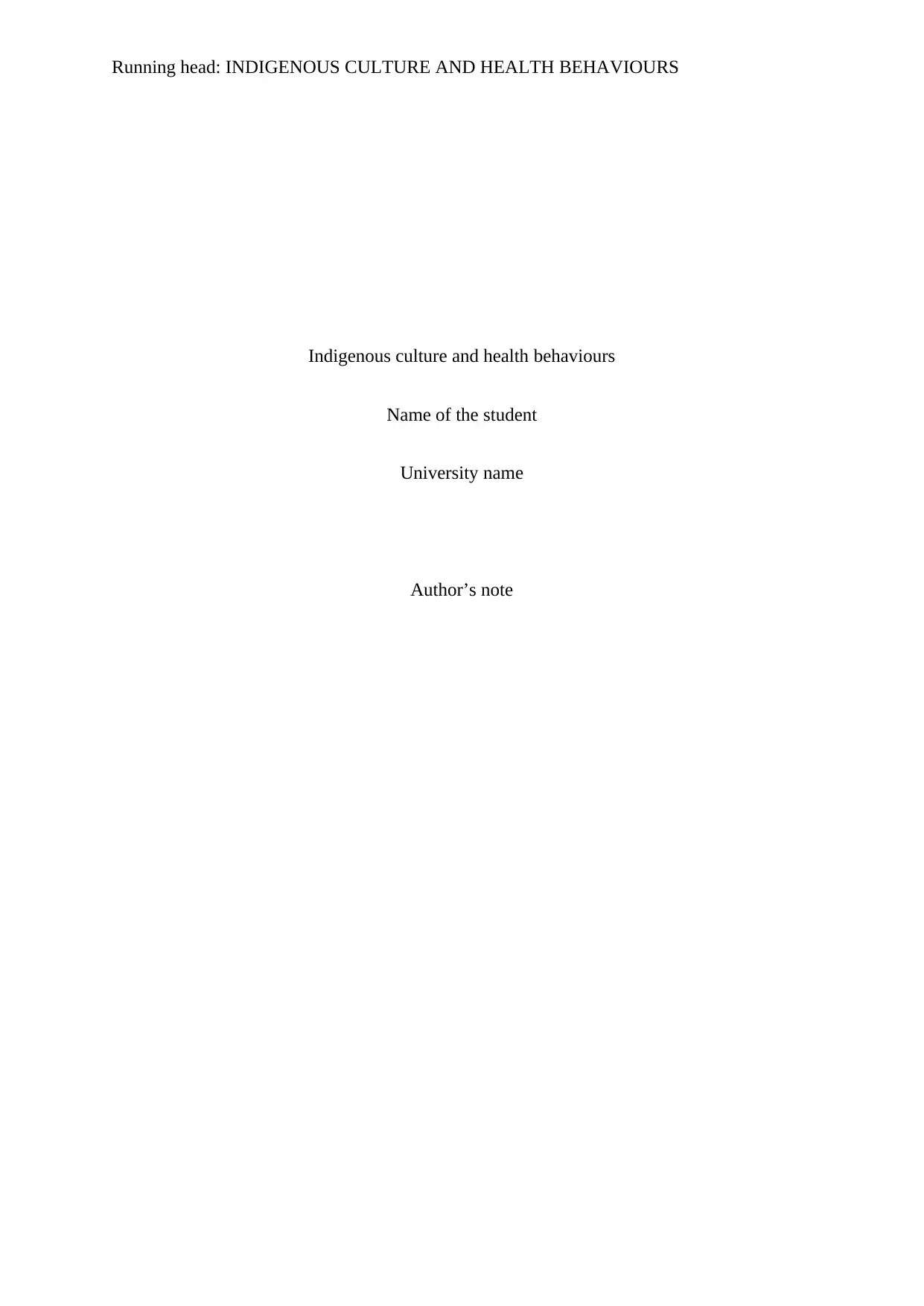
Running head: INDIGENOUS CULTURE AND HEALTH BEHAVIOURS
Indigenous culture and health behaviours
Name of the student
University name
Author’s note
Indigenous culture and health behaviours
Name of the student
University name
Author’s note
Paraphrase This Document
Need a fresh take? Get an instant paraphrase of this document with our AI Paraphraser
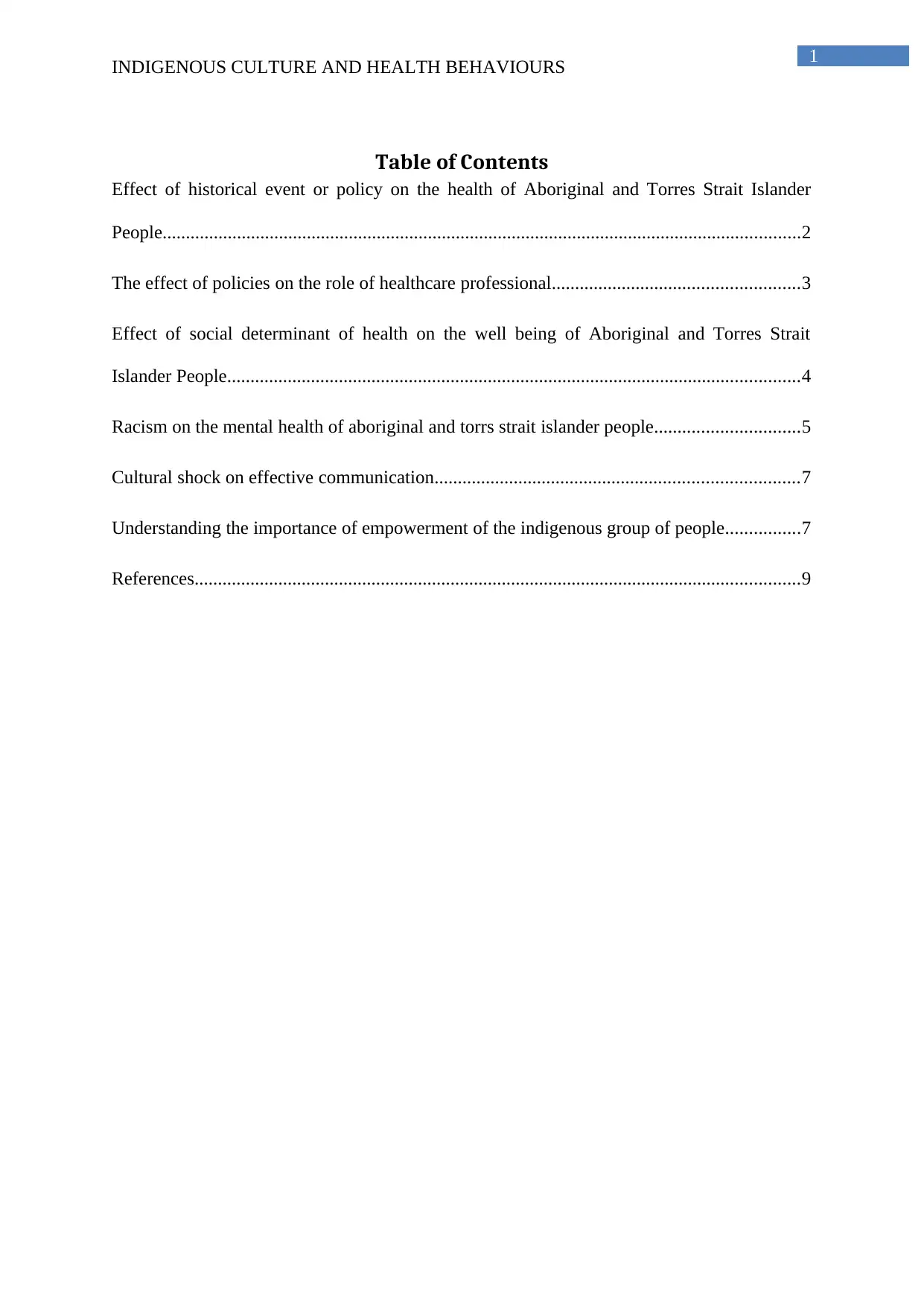
1
INDIGENOUS CULTURE AND HEALTH BEHAVIOURS
Table of Contents
Effect of historical event or policy on the health of Aboriginal and Torres Strait Islander
People.........................................................................................................................................2
The effect of policies on the role of healthcare professional.....................................................3
Effect of social determinant of health on the well being of Aboriginal and Torres Strait
Islander People...........................................................................................................................4
Racism on the mental health of aboriginal and torrs strait islander people...............................5
Cultural shock on effective communication..............................................................................7
Understanding the importance of empowerment of the indigenous group of people................7
References..................................................................................................................................9
INDIGENOUS CULTURE AND HEALTH BEHAVIOURS
Table of Contents
Effect of historical event or policy on the health of Aboriginal and Torres Strait Islander
People.........................................................................................................................................2
The effect of policies on the role of healthcare professional.....................................................3
Effect of social determinant of health on the well being of Aboriginal and Torres Strait
Islander People...........................................................................................................................4
Racism on the mental health of aboriginal and torrs strait islander people...............................5
Cultural shock on effective communication..............................................................................7
Understanding the importance of empowerment of the indigenous group of people................7
References..................................................................................................................................9
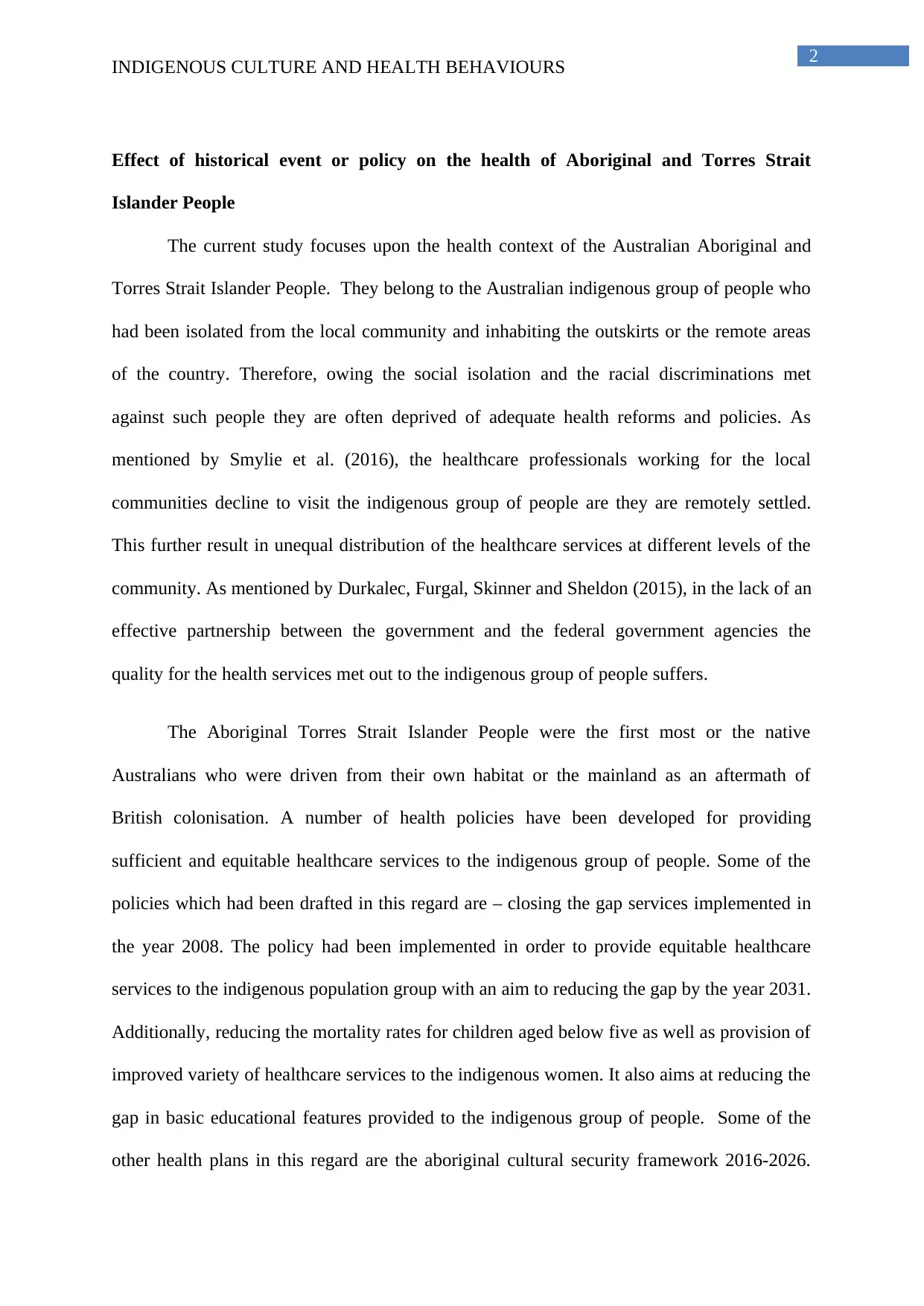
2
INDIGENOUS CULTURE AND HEALTH BEHAVIOURS
Effect of historical event or policy on the health of Aboriginal and Torres Strait
Islander People
The current study focuses upon the health context of the Australian Aboriginal and
Torres Strait Islander People. They belong to the Australian indigenous group of people who
had been isolated from the local community and inhabiting the outskirts or the remote areas
of the country. Therefore, owing the social isolation and the racial discriminations met
against such people they are often deprived of adequate health reforms and policies. As
mentioned by Smylie et al. (2016), the healthcare professionals working for the local
communities decline to visit the indigenous group of people are they are remotely settled.
This further result in unequal distribution of the healthcare services at different levels of the
community. As mentioned by Durkalec, Furgal, Skinner and Sheldon (2015), in the lack of an
effective partnership between the government and the federal government agencies the
quality for the health services met out to the indigenous group of people suffers.
The Aboriginal Torres Strait Islander People were the first most or the native
Australians who were driven from their own habitat or the mainland as an aftermath of
British colonisation. A number of health policies have been developed for providing
sufficient and equitable healthcare services to the indigenous group of people. Some of the
policies which had been drafted in this regard are – closing the gap services implemented in
the year 2008. The policy had been implemented in order to provide equitable healthcare
services to the indigenous population group with an aim to reducing the gap by the year 2031.
Additionally, reducing the mortality rates for children aged below five as well as provision of
improved variety of healthcare services to the indigenous women. It also aims at reducing the
gap in basic educational features provided to the indigenous group of people. Some of the
other health plans in this regard are the aboriginal cultural security framework 2016-2026.
INDIGENOUS CULTURE AND HEALTH BEHAVIOURS
Effect of historical event or policy on the health of Aboriginal and Torres Strait
Islander People
The current study focuses upon the health context of the Australian Aboriginal and
Torres Strait Islander People. They belong to the Australian indigenous group of people who
had been isolated from the local community and inhabiting the outskirts or the remote areas
of the country. Therefore, owing the social isolation and the racial discriminations met
against such people they are often deprived of adequate health reforms and policies. As
mentioned by Smylie et al. (2016), the healthcare professionals working for the local
communities decline to visit the indigenous group of people are they are remotely settled.
This further result in unequal distribution of the healthcare services at different levels of the
community. As mentioned by Durkalec, Furgal, Skinner and Sheldon (2015), in the lack of an
effective partnership between the government and the federal government agencies the
quality for the health services met out to the indigenous group of people suffers.
The Aboriginal Torres Strait Islander People were the first most or the native
Australians who were driven from their own habitat or the mainland as an aftermath of
British colonisation. A number of health policies have been developed for providing
sufficient and equitable healthcare services to the indigenous group of people. Some of the
policies which had been drafted in this regard are – closing the gap services implemented in
the year 2008. The policy had been implemented in order to provide equitable healthcare
services to the indigenous population group with an aim to reducing the gap by the year 2031.
Additionally, reducing the mortality rates for children aged below five as well as provision of
improved variety of healthcare services to the indigenous women. It also aims at reducing the
gap in basic educational features provided to the indigenous group of people. Some of the
other health plans in this regard are the aboriginal cultural security framework 2016-2026.
⊘ This is a preview!⊘
Do you want full access?
Subscribe today to unlock all pages.

Trusted by 1+ million students worldwide
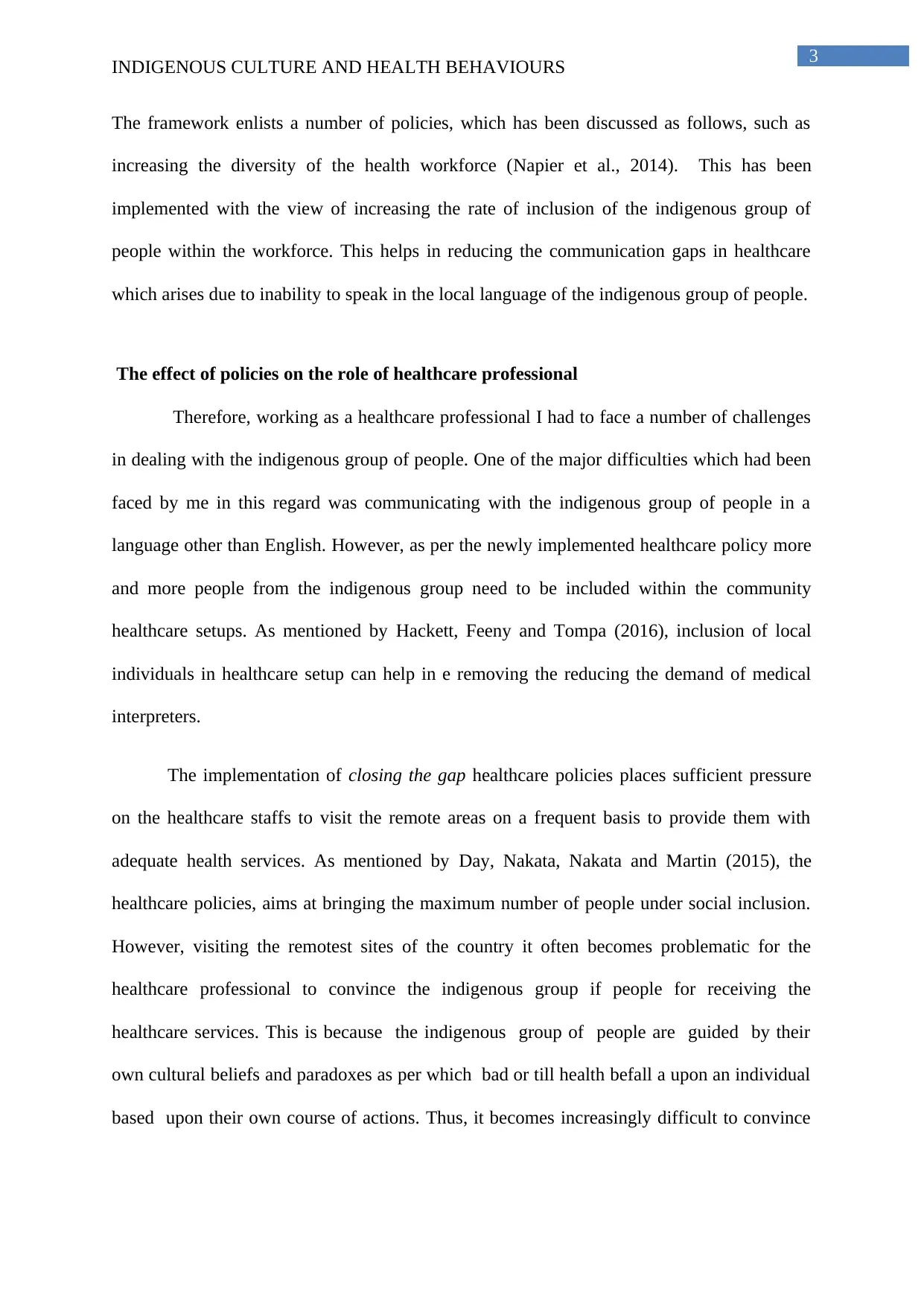
3
INDIGENOUS CULTURE AND HEALTH BEHAVIOURS
The framework enlists a number of policies, which has been discussed as follows, such as
increasing the diversity of the health workforce (Napier et al., 2014). This has been
implemented with the view of increasing the rate of inclusion of the indigenous group of
people within the workforce. This helps in reducing the communication gaps in healthcare
which arises due to inability to speak in the local language of the indigenous group of people.
The effect of policies on the role of healthcare professional
Therefore, working as a healthcare professional I had to face a number of challenges
in dealing with the indigenous group of people. One of the major difficulties which had been
faced by me in this regard was communicating with the indigenous group of people in a
language other than English. However, as per the newly implemented healthcare policy more
and more people from the indigenous group need to be included within the community
healthcare setups. As mentioned by Hackett, Feeny and Tompa (2016), inclusion of local
individuals in healthcare setup can help in e removing the reducing the demand of medical
interpreters.
The implementation of closing the gap healthcare policies places sufficient pressure
on the healthcare staffs to visit the remote areas on a frequent basis to provide them with
adequate health services. As mentioned by Day, Nakata, Nakata and Martin (2015), the
healthcare policies, aims at bringing the maximum number of people under social inclusion.
However, visiting the remotest sites of the country it often becomes problematic for the
healthcare professional to convince the indigenous group if people for receiving the
healthcare services. This is because the indigenous group of people are guided by their
own cultural beliefs and paradoxes as per which bad or till health befall a upon an individual
based upon their own course of actions. Thus, it becomes increasingly difficult to convince
INDIGENOUS CULTURE AND HEALTH BEHAVIOURS
The framework enlists a number of policies, which has been discussed as follows, such as
increasing the diversity of the health workforce (Napier et al., 2014). This has been
implemented with the view of increasing the rate of inclusion of the indigenous group of
people within the workforce. This helps in reducing the communication gaps in healthcare
which arises due to inability to speak in the local language of the indigenous group of people.
The effect of policies on the role of healthcare professional
Therefore, working as a healthcare professional I had to face a number of challenges
in dealing with the indigenous group of people. One of the major difficulties which had been
faced by me in this regard was communicating with the indigenous group of people in a
language other than English. However, as per the newly implemented healthcare policy more
and more people from the indigenous group need to be included within the community
healthcare setups. As mentioned by Hackett, Feeny and Tompa (2016), inclusion of local
individuals in healthcare setup can help in e removing the reducing the demand of medical
interpreters.
The implementation of closing the gap healthcare policies places sufficient pressure
on the healthcare staffs to visit the remote areas on a frequent basis to provide them with
adequate health services. As mentioned by Day, Nakata, Nakata and Martin (2015), the
healthcare policies, aims at bringing the maximum number of people under social inclusion.
However, visiting the remotest sites of the country it often becomes problematic for the
healthcare professional to convince the indigenous group if people for receiving the
healthcare services. This is because the indigenous group of people are guided by their
own cultural beliefs and paradoxes as per which bad or till health befall a upon an individual
based upon their own course of actions. Thus, it becomes increasingly difficult to convince
Paraphrase This Document
Need a fresh take? Get an instant paraphrase of this document with our AI Paraphraser

4
INDIGENOUS CULTURE AND HEALTH BEHAVIOURS
the parents regarding the fact that their children need to be provided with vaccinations to
prevent the occurrence of diseases.
Effect of social determinant of health on the well being of Aboriginal and Torres Strait
Islander People
There are a number of social determinants of health which had been affecting the
health of the indigenous group of people considerably. Some of these could be presented as
follows such as the influences of the past upon the present life situations of the indigenous
group of people, the system of stratification of the Australian society and the effect of poor
economic conditions on the overall health patterns of the society.
For example, the past history of abuse and negligence may affect the present status of
health of an individual. Additionally, the layers of stratifications present within the Australian
society further add to the grievances of social exclusion suffered by the Australian indigenous
group of people. As mentioned by Kolahdooz et al. (2014), the social stratification is the
grouping of the society into different categories and classes with different levels of access to
power and privileges. For example, the indigenous group of people has to wait in the
hospitals for long hours before receiving the support care services. This could be attributed to
the lack of concern as well as effective communications between the patients and the hospital
authorities.
The social stratification was also seen in the division of labour within the Australian
society. As per the Australian society some of the topmost and most highly rated
professionals were those of doctors, engineers, lawyers , professors etc , whereas the ones
performing less significant jobs such as clergyman, truck drivers , sweepers etc were looked
down upon by the society. As mentioned by Eckermann, Dowd and Chong (2010), the
social stratifications have also been reflected within the paying system, of the society where
INDIGENOUS CULTURE AND HEALTH BEHAVIOURS
the parents regarding the fact that their children need to be provided with vaccinations to
prevent the occurrence of diseases.
Effect of social determinant of health on the well being of Aboriginal and Torres Strait
Islander People
There are a number of social determinants of health which had been affecting the
health of the indigenous group of people considerably. Some of these could be presented as
follows such as the influences of the past upon the present life situations of the indigenous
group of people, the system of stratification of the Australian society and the effect of poor
economic conditions on the overall health patterns of the society.
For example, the past history of abuse and negligence may affect the present status of
health of an individual. Additionally, the layers of stratifications present within the Australian
society further add to the grievances of social exclusion suffered by the Australian indigenous
group of people. As mentioned by Kolahdooz et al. (2014), the social stratification is the
grouping of the society into different categories and classes with different levels of access to
power and privileges. For example, the indigenous group of people has to wait in the
hospitals for long hours before receiving the support care services. This could be attributed to
the lack of concern as well as effective communications between the patients and the hospital
authorities.
The social stratification was also seen in the division of labour within the Australian
society. As per the Australian society some of the topmost and most highly rated
professionals were those of doctors, engineers, lawyers , professors etc , whereas the ones
performing less significant jobs such as clergyman, truck drivers , sweepers etc were looked
down upon by the society. As mentioned by Eckermann, Dowd and Chong (2010), the
social stratifications have also been reflected within the paying system, of the society where
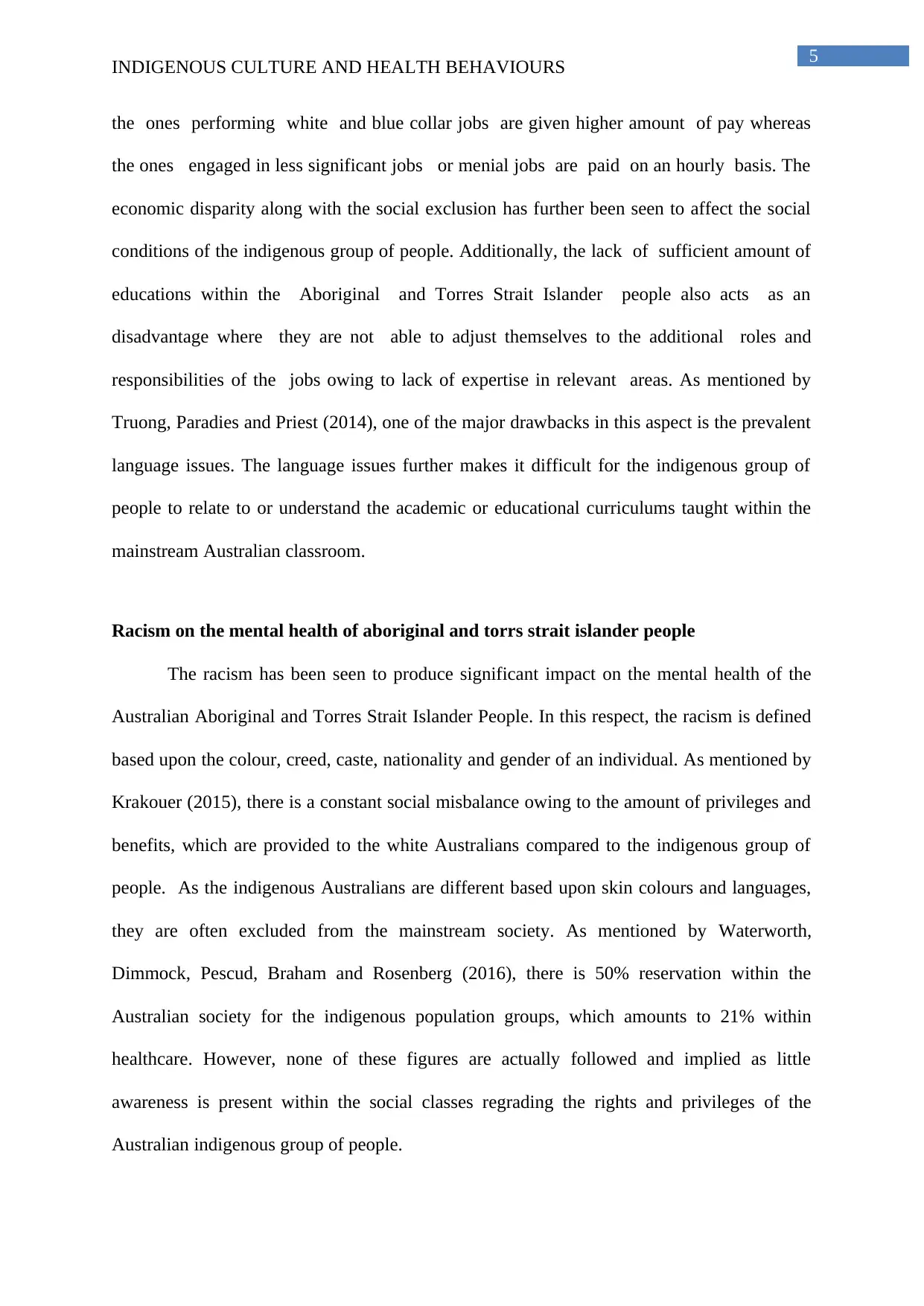
5
INDIGENOUS CULTURE AND HEALTH BEHAVIOURS
the ones performing white and blue collar jobs are given higher amount of pay whereas
the ones engaged in less significant jobs or menial jobs are paid on an hourly basis. The
economic disparity along with the social exclusion has further been seen to affect the social
conditions of the indigenous group of people. Additionally, the lack of sufficient amount of
educations within the Aboriginal and Torres Strait Islander people also acts as an
disadvantage where they are not able to adjust themselves to the additional roles and
responsibilities of the jobs owing to lack of expertise in relevant areas. As mentioned by
Truong, Paradies and Priest (2014), one of the major drawbacks in this aspect is the prevalent
language issues. The language issues further makes it difficult for the indigenous group of
people to relate to or understand the academic or educational curriculums taught within the
mainstream Australian classroom.
Racism on the mental health of aboriginal and torrs strait islander people
The racism has been seen to produce significant impact on the mental health of the
Australian Aboriginal and Torres Strait Islander People. In this respect, the racism is defined
based upon the colour, creed, caste, nationality and gender of an individual. As mentioned by
Krakouer (2015), there is a constant social misbalance owing to the amount of privileges and
benefits, which are provided to the white Australians compared to the indigenous group of
people. As the indigenous Australians are different based upon skin colours and languages,
they are often excluded from the mainstream society. As mentioned by Waterworth,
Dimmock, Pescud, Braham and Rosenberg (2016), there is 50% reservation within the
Australian society for the indigenous population groups, which amounts to 21% within
healthcare. However, none of these figures are actually followed and implied as little
awareness is present within the social classes regrading the rights and privileges of the
Australian indigenous group of people.
INDIGENOUS CULTURE AND HEALTH BEHAVIOURS
the ones performing white and blue collar jobs are given higher amount of pay whereas
the ones engaged in less significant jobs or menial jobs are paid on an hourly basis. The
economic disparity along with the social exclusion has further been seen to affect the social
conditions of the indigenous group of people. Additionally, the lack of sufficient amount of
educations within the Aboriginal and Torres Strait Islander people also acts as an
disadvantage where they are not able to adjust themselves to the additional roles and
responsibilities of the jobs owing to lack of expertise in relevant areas. As mentioned by
Truong, Paradies and Priest (2014), one of the major drawbacks in this aspect is the prevalent
language issues. The language issues further makes it difficult for the indigenous group of
people to relate to or understand the academic or educational curriculums taught within the
mainstream Australian classroom.
Racism on the mental health of aboriginal and torrs strait islander people
The racism has been seen to produce significant impact on the mental health of the
Australian Aboriginal and Torres Strait Islander People. In this respect, the racism is defined
based upon the colour, creed, caste, nationality and gender of an individual. As mentioned by
Krakouer (2015), there is a constant social misbalance owing to the amount of privileges and
benefits, which are provided to the white Australians compared to the indigenous group of
people. As the indigenous Australians are different based upon skin colours and languages,
they are often excluded from the mainstream society. As mentioned by Waterworth,
Dimmock, Pescud, Braham and Rosenberg (2016), there is 50% reservation within the
Australian society for the indigenous population groups, which amounts to 21% within
healthcare. However, none of these figures are actually followed and implied as little
awareness is present within the social classes regrading the rights and privileges of the
Australian indigenous group of people.
⊘ This is a preview!⊘
Do you want full access?
Subscribe today to unlock all pages.

Trusted by 1+ million students worldwide
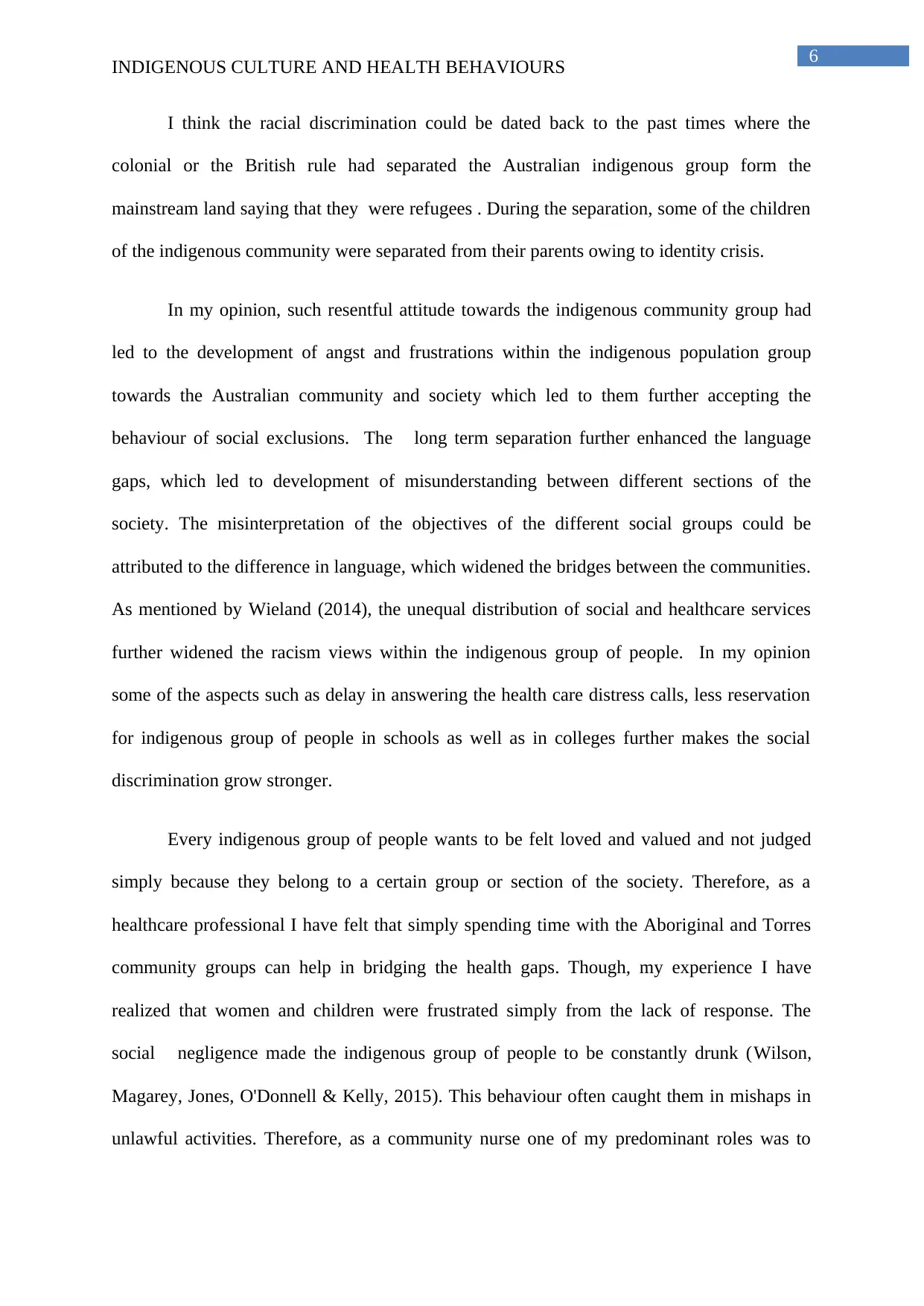
6
INDIGENOUS CULTURE AND HEALTH BEHAVIOURS
I think the racial discrimination could be dated back to the past times where the
colonial or the British rule had separated the Australian indigenous group form the
mainstream land saying that they were refugees . During the separation, some of the children
of the indigenous community were separated from their parents owing to identity crisis.
In my opinion, such resentful attitude towards the indigenous community group had
led to the development of angst and frustrations within the indigenous population group
towards the Australian community and society which led to them further accepting the
behaviour of social exclusions. The long term separation further enhanced the language
gaps, which led to development of misunderstanding between different sections of the
society. The misinterpretation of the objectives of the different social groups could be
attributed to the difference in language, which widened the bridges between the communities.
As mentioned by Wieland (2014), the unequal distribution of social and healthcare services
further widened the racism views within the indigenous group of people. In my opinion
some of the aspects such as delay in answering the health care distress calls, less reservation
for indigenous group of people in schools as well as in colleges further makes the social
discrimination grow stronger.
Every indigenous group of people wants to be felt loved and valued and not judged
simply because they belong to a certain group or section of the society. Therefore, as a
healthcare professional I have felt that simply spending time with the Aboriginal and Torres
community groups can help in bridging the health gaps. Though, my experience I have
realized that women and children were frustrated simply from the lack of response. The
social negligence made the indigenous group of people to be constantly drunk (Wilson,
Magarey, Jones, O'Donnell & Kelly, 2015). This behaviour often caught them in mishaps in
unlawful activities. Therefore, as a community nurse one of my predominant roles was to
INDIGENOUS CULTURE AND HEALTH BEHAVIOURS
I think the racial discrimination could be dated back to the past times where the
colonial or the British rule had separated the Australian indigenous group form the
mainstream land saying that they were refugees . During the separation, some of the children
of the indigenous community were separated from their parents owing to identity crisis.
In my opinion, such resentful attitude towards the indigenous community group had
led to the development of angst and frustrations within the indigenous population group
towards the Australian community and society which led to them further accepting the
behaviour of social exclusions. The long term separation further enhanced the language
gaps, which led to development of misunderstanding between different sections of the
society. The misinterpretation of the objectives of the different social groups could be
attributed to the difference in language, which widened the bridges between the communities.
As mentioned by Wieland (2014), the unequal distribution of social and healthcare services
further widened the racism views within the indigenous group of people. In my opinion
some of the aspects such as delay in answering the health care distress calls, less reservation
for indigenous group of people in schools as well as in colleges further makes the social
discrimination grow stronger.
Every indigenous group of people wants to be felt loved and valued and not judged
simply because they belong to a certain group or section of the society. Therefore, as a
healthcare professional I have felt that simply spending time with the Aboriginal and Torres
community groups can help in bridging the health gaps. Though, my experience I have
realized that women and children were frustrated simply from the lack of response. The
social negligence made the indigenous group of people to be constantly drunk (Wilson,
Magarey, Jones, O'Donnell & Kelly, 2015). This behaviour often caught them in mishaps in
unlawful activities. Therefore, as a community nurse one of my predominant roles was to
Paraphrase This Document
Need a fresh take? Get an instant paraphrase of this document with our AI Paraphraser
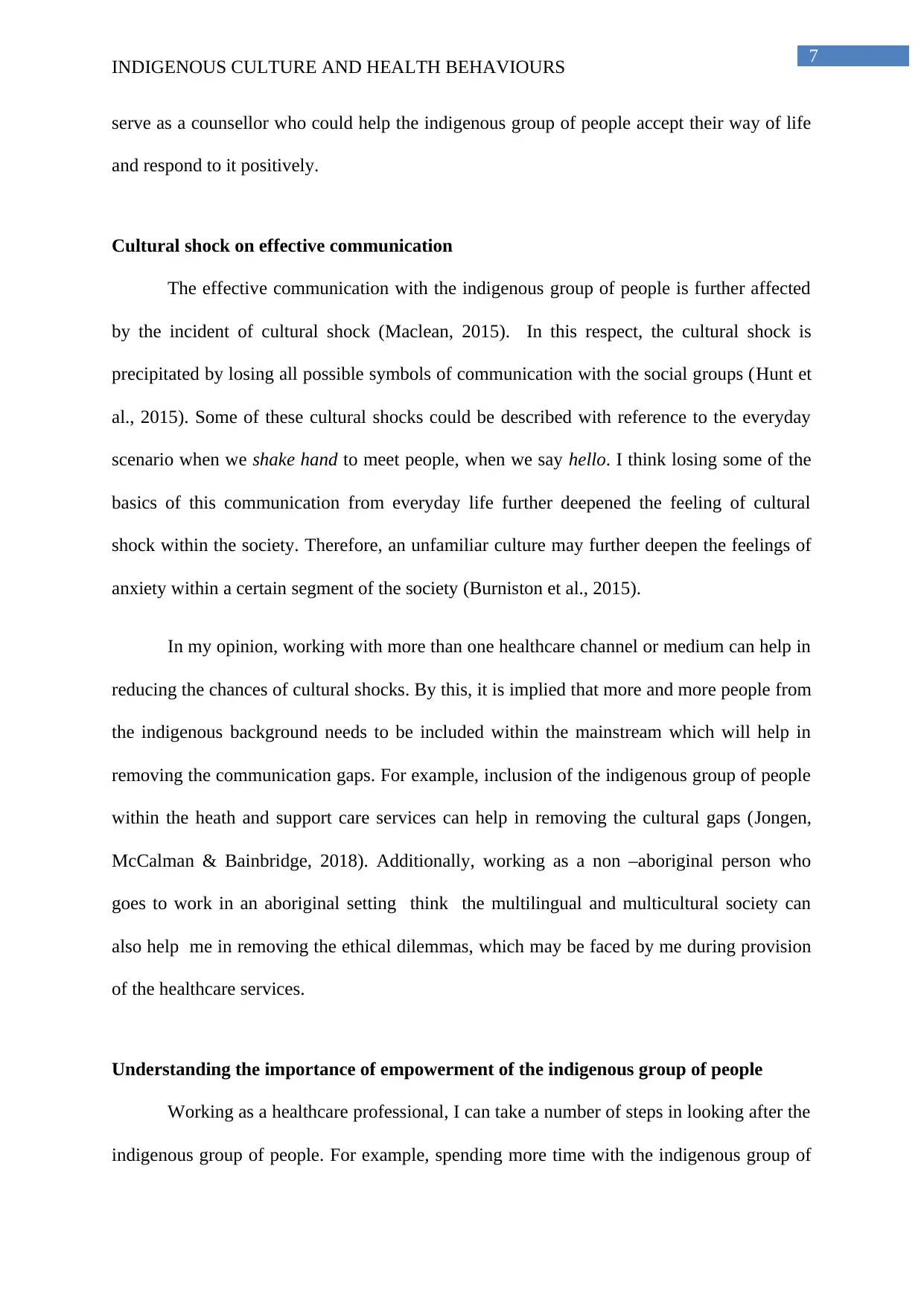
7
INDIGENOUS CULTURE AND HEALTH BEHAVIOURS
serve as a counsellor who could help the indigenous group of people accept their way of life
and respond to it positively.
Cultural shock on effective communication
The effective communication with the indigenous group of people is further affected
by the incident of cultural shock (Maclean, 2015). In this respect, the cultural shock is
precipitated by losing all possible symbols of communication with the social groups (Hunt et
al., 2015). Some of these cultural shocks could be described with reference to the everyday
scenario when we shake hand to meet people, when we say hello. I think losing some of the
basics of this communication from everyday life further deepened the feeling of cultural
shock within the society. Therefore, an unfamiliar culture may further deepen the feelings of
anxiety within a certain segment of the society (Burniston et al., 2015).
In my opinion, working with more than one healthcare channel or medium can help in
reducing the chances of cultural shocks. By this, it is implied that more and more people from
the indigenous background needs to be included within the mainstream which will help in
removing the communication gaps. For example, inclusion of the indigenous group of people
within the heath and support care services can help in removing the cultural gaps (Jongen,
McCalman & Bainbridge, 2018). Additionally, working as a non –aboriginal person who
goes to work in an aboriginal setting think the multilingual and multicultural society can
also help me in removing the ethical dilemmas, which may be faced by me during provision
of the healthcare services.
Understanding the importance of empowerment of the indigenous group of people
Working as a healthcare professional, I can take a number of steps in looking after the
indigenous group of people. For example, spending more time with the indigenous group of
INDIGENOUS CULTURE AND HEALTH BEHAVIOURS
serve as a counsellor who could help the indigenous group of people accept their way of life
and respond to it positively.
Cultural shock on effective communication
The effective communication with the indigenous group of people is further affected
by the incident of cultural shock (Maclean, 2015). In this respect, the cultural shock is
precipitated by losing all possible symbols of communication with the social groups (Hunt et
al., 2015). Some of these cultural shocks could be described with reference to the everyday
scenario when we shake hand to meet people, when we say hello. I think losing some of the
basics of this communication from everyday life further deepened the feeling of cultural
shock within the society. Therefore, an unfamiliar culture may further deepen the feelings of
anxiety within a certain segment of the society (Burniston et al., 2015).
In my opinion, working with more than one healthcare channel or medium can help in
reducing the chances of cultural shocks. By this, it is implied that more and more people from
the indigenous background needs to be included within the mainstream which will help in
removing the communication gaps. For example, inclusion of the indigenous group of people
within the heath and support care services can help in removing the cultural gaps (Jongen,
McCalman & Bainbridge, 2018). Additionally, working as a non –aboriginal person who
goes to work in an aboriginal setting think the multilingual and multicultural society can
also help me in removing the ethical dilemmas, which may be faced by me during provision
of the healthcare services.
Understanding the importance of empowerment of the indigenous group of people
Working as a healthcare professional, I can take a number of steps in looking after the
indigenous group of people. For example, spending more time with the indigenous group of
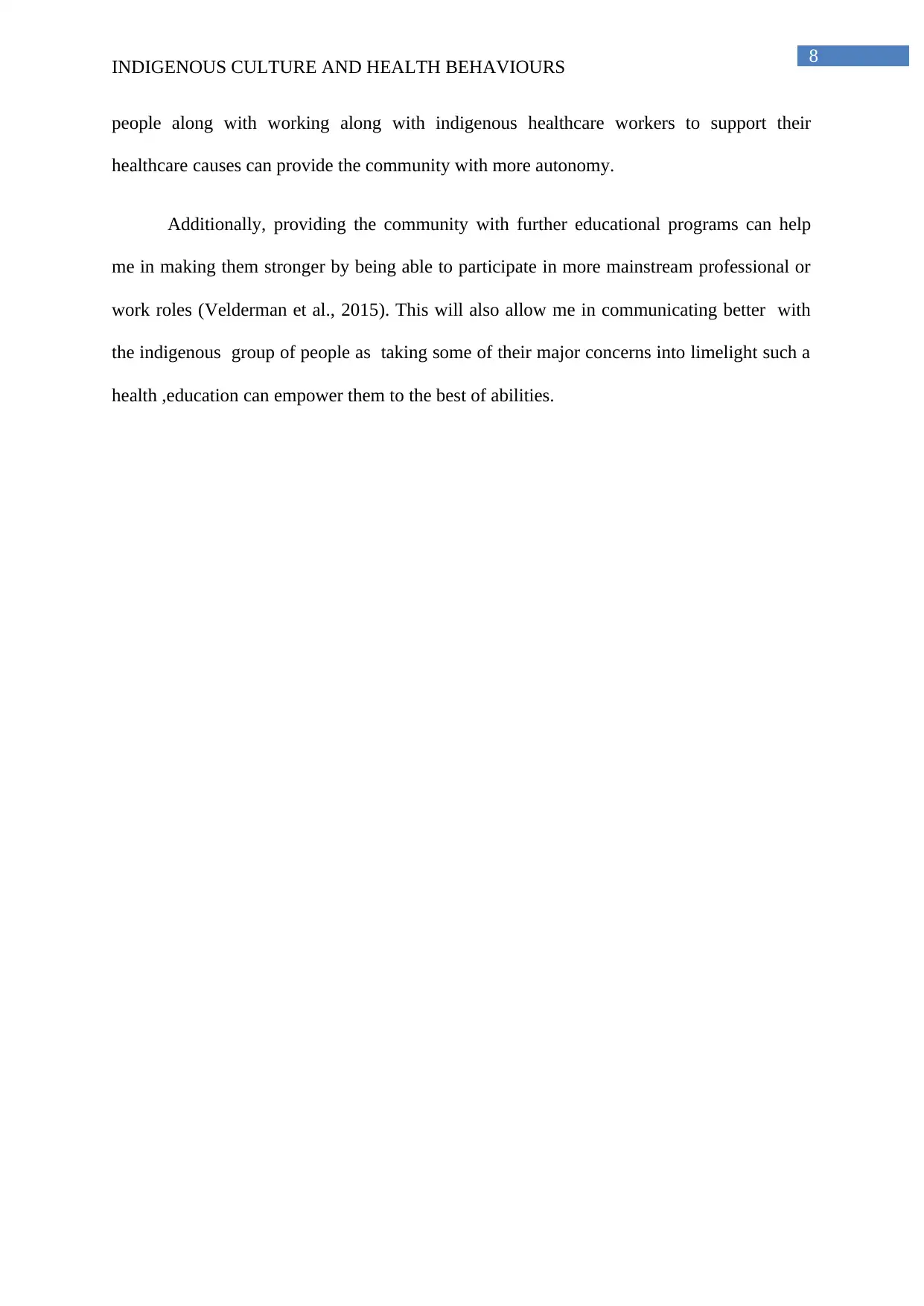
8
INDIGENOUS CULTURE AND HEALTH BEHAVIOURS
people along with working along with indigenous healthcare workers to support their
healthcare causes can provide the community with more autonomy.
Additionally, providing the community with further educational programs can help
me in making them stronger by being able to participate in more mainstream professional or
work roles (Velderman et al., 2015). This will also allow me in communicating better with
the indigenous group of people as taking some of their major concerns into limelight such a
health ,education can empower them to the best of abilities.
INDIGENOUS CULTURE AND HEALTH BEHAVIOURS
people along with working along with indigenous healthcare workers to support their
healthcare causes can provide the community with more autonomy.
Additionally, providing the community with further educational programs can help
me in making them stronger by being able to participate in more mainstream professional or
work roles (Velderman et al., 2015). This will also allow me in communicating better with
the indigenous group of people as taking some of their major concerns into limelight such a
health ,education can empower them to the best of abilities.
⊘ This is a preview!⊘
Do you want full access?
Subscribe today to unlock all pages.

Trusted by 1+ million students worldwide

9
INDIGENOUS CULTURE AND HEALTH BEHAVIOURS
References
Burniston, S., Okello, A. L., Khamlome, B., Inthavong, P., Gilbert, J., Blacksell, S. D., ... &
Welburn, S. C. (2015). Cultural drivers and health-seeking behaviours that impact on
the transmission of pig-associated zoonoses in Lao People’s Democratic
Republic. Infectious diseases of poverty, 4(1), 11. Retrieved at:
https://doi.org/10.1186/2049-9957-4-11
Day, A., Nakata, V., Nakata, M., & Martin, G. (2015). Indigenous students' persistence in
higher education in Australia: contextualising models of change from psychology to
understand and aid students' practices at a cultural interface. Higher Education
Research & Development, 34(3), 501-512. Retrieved at:
https://doi.org/10.1080/07294360.2014.973379
Durkalec, A., Furgal, C., Skinner, M. W., & Sheldon, T. (2015). Climate change influences
on environment as a determinant of Indigenous health: Relationships to place, sea ice,
and health in an Inuit community. Social Science & Medicine, 136, 17-26. Retrieved
at: https://doi.org/10.1016/j.socscimed.2015.04.026
Eckermann, A. K., Dowd, T., & Chong, E. (2010). Binan Goonj: bridging cultures in
Aboriginal health. Elsevier Australia, 55-68. Retrieved at:
https://books.google.co.in/books?hl=en&lr=&id=d-
ZfzJNACu0C&oi=fnd&pg=PR9&dq=Eckermann,+A.+K.,+Dowd,+T.,+%26+Chong,
+E.+(2010).+Binan+Goonj:+bridging+cultures+in+Aboriginal+health.
+Elsevier+Australia,+55-
68&ots=P6ZrpYzpKF&sig=_zZkoZtLZbBUBQ6zQ0FjNfc0Vc4&redir_esc=y#v=one
page&q&f=false
INDIGENOUS CULTURE AND HEALTH BEHAVIOURS
References
Burniston, S., Okello, A. L., Khamlome, B., Inthavong, P., Gilbert, J., Blacksell, S. D., ... &
Welburn, S. C. (2015). Cultural drivers and health-seeking behaviours that impact on
the transmission of pig-associated zoonoses in Lao People’s Democratic
Republic. Infectious diseases of poverty, 4(1), 11. Retrieved at:
https://doi.org/10.1186/2049-9957-4-11
Day, A., Nakata, V., Nakata, M., & Martin, G. (2015). Indigenous students' persistence in
higher education in Australia: contextualising models of change from psychology to
understand and aid students' practices at a cultural interface. Higher Education
Research & Development, 34(3), 501-512. Retrieved at:
https://doi.org/10.1080/07294360.2014.973379
Durkalec, A., Furgal, C., Skinner, M. W., & Sheldon, T. (2015). Climate change influences
on environment as a determinant of Indigenous health: Relationships to place, sea ice,
and health in an Inuit community. Social Science & Medicine, 136, 17-26. Retrieved
at: https://doi.org/10.1016/j.socscimed.2015.04.026
Eckermann, A. K., Dowd, T., & Chong, E. (2010). Binan Goonj: bridging cultures in
Aboriginal health. Elsevier Australia, 55-68. Retrieved at:
https://books.google.co.in/books?hl=en&lr=&id=d-
ZfzJNACu0C&oi=fnd&pg=PR9&dq=Eckermann,+A.+K.,+Dowd,+T.,+%26+Chong,
+E.+(2010).+Binan+Goonj:+bridging+cultures+in+Aboriginal+health.
+Elsevier+Australia,+55-
68&ots=P6ZrpYzpKF&sig=_zZkoZtLZbBUBQ6zQ0FjNfc0Vc4&redir_esc=y#v=one
page&q&f=false
Paraphrase This Document
Need a fresh take? Get an instant paraphrase of this document with our AI Paraphraser

10
INDIGENOUS CULTURE AND HEALTH BEHAVIOURS
Hackett, C., Feeny, D., & Tompa, E. (2016). Canada's residential school system: measuring
the intergenerational impact of familial attendance on health and mental health
outcomes. J Epidemiol Community Health, jech-2016, 55-98. Retrieved at:
http://dx.doi.org/10.1136/jech-2016-207380
Hunt, L., Ramjan, L., McDonald, G., Koch, J., Baird, D., & Salamonson, Y. (2015). Nursing
students' perspectives of the health and healthcare issues of Australian Indigenous
people. Nurse education today, 35(3), 461-467. DOI: Retrieved at:
https://doi.org/10.1016/j.nedt.2014.11.019
Jongen, C., McCalman, J., & Bainbridge, R. (2018). Health workforce cultural competency
interventions: A systematic scoping review. BMC health services research, 18(1),
232. https://doi.org/10.1186/s12913-018-3001-5
Kolahdooz, F., Jang, S. L., Corriveau, A., Gotay, C., Johnston, N., & Sharma, S. (2014).
Knowledge, attitudes, and behaviours towards cancer screening in indigenous
populations: a systematic review. The Lancet Oncology, 15(11), e504-e516. Retrieved
at: https://doi.org/10.1016/S1470-2045(14)70508-X
Krakouer, J. (2015). Literature review relating to the current context and discourse on
Indigenous cultural awareness in the teaching space: Critical pedagogies and
improving Indigenous learning outcomes through cultural responsiveness, 105-215.
Retrieved at: https://research.acer.edu.au/indigenous_education/42/
Maclean, K. (2015). Crossing cultural boundaries: Integrating Indigenous water knowledge
into water governance through co-research in the Queensland Wet Tropics,
Australia. Geoforum, 59, 142-152. Retrieved at:
https://doi.org/10.1016/j.geoforum.2014.12.008
INDIGENOUS CULTURE AND HEALTH BEHAVIOURS
Hackett, C., Feeny, D., & Tompa, E. (2016). Canada's residential school system: measuring
the intergenerational impact of familial attendance on health and mental health
outcomes. J Epidemiol Community Health, jech-2016, 55-98. Retrieved at:
http://dx.doi.org/10.1136/jech-2016-207380
Hunt, L., Ramjan, L., McDonald, G., Koch, J., Baird, D., & Salamonson, Y. (2015). Nursing
students' perspectives of the health and healthcare issues of Australian Indigenous
people. Nurse education today, 35(3), 461-467. DOI: Retrieved at:
https://doi.org/10.1016/j.nedt.2014.11.019
Jongen, C., McCalman, J., & Bainbridge, R. (2018). Health workforce cultural competency
interventions: A systematic scoping review. BMC health services research, 18(1),
232. https://doi.org/10.1186/s12913-018-3001-5
Kolahdooz, F., Jang, S. L., Corriveau, A., Gotay, C., Johnston, N., & Sharma, S. (2014).
Knowledge, attitudes, and behaviours towards cancer screening in indigenous
populations: a systematic review. The Lancet Oncology, 15(11), e504-e516. Retrieved
at: https://doi.org/10.1016/S1470-2045(14)70508-X
Krakouer, J. (2015). Literature review relating to the current context and discourse on
Indigenous cultural awareness in the teaching space: Critical pedagogies and
improving Indigenous learning outcomes through cultural responsiveness, 105-215.
Retrieved at: https://research.acer.edu.au/indigenous_education/42/
Maclean, K. (2015). Crossing cultural boundaries: Integrating Indigenous water knowledge
into water governance through co-research in the Queensland Wet Tropics,
Australia. Geoforum, 59, 142-152. Retrieved at:
https://doi.org/10.1016/j.geoforum.2014.12.008
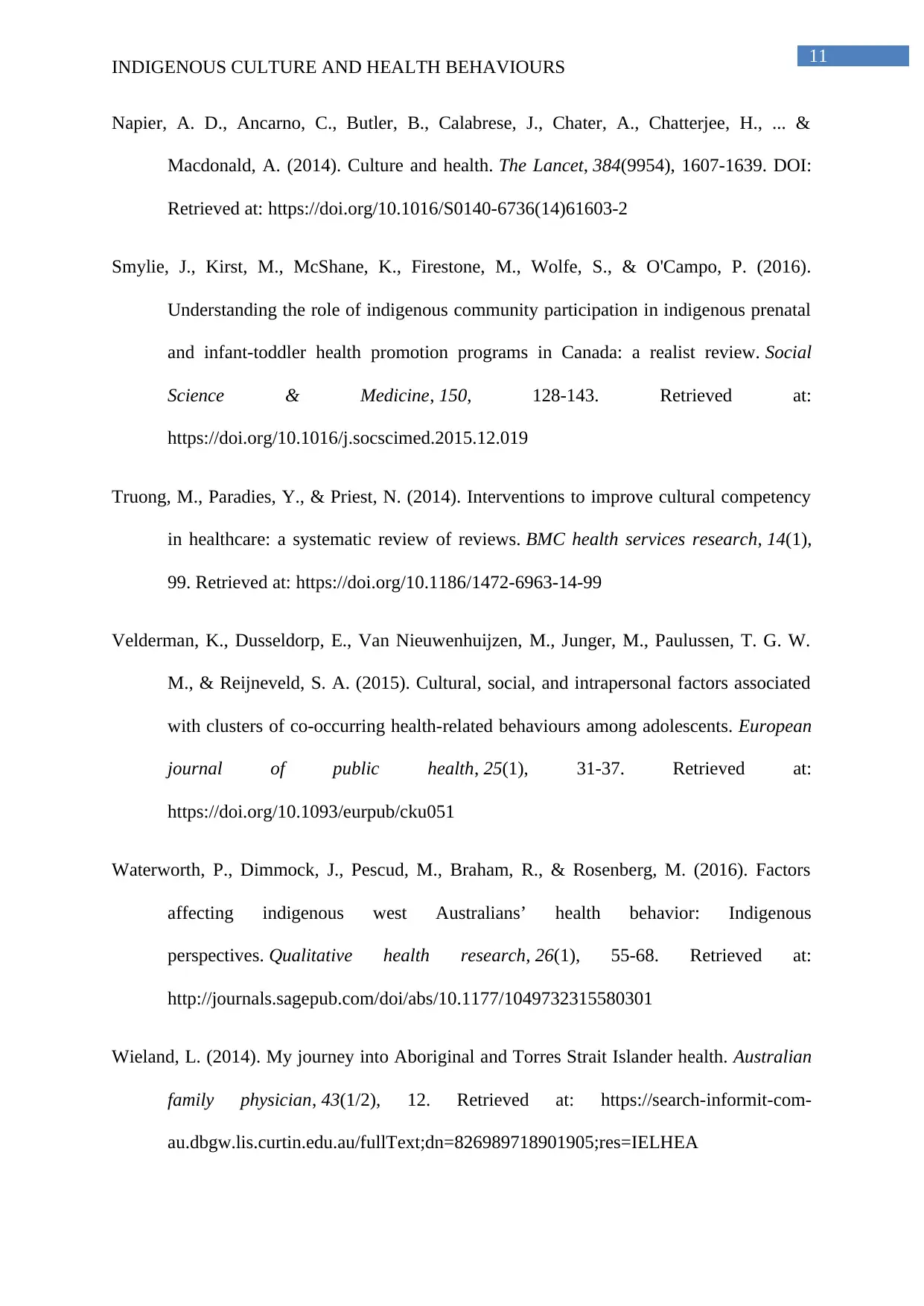
11
INDIGENOUS CULTURE AND HEALTH BEHAVIOURS
Napier, A. D., Ancarno, C., Butler, B., Calabrese, J., Chater, A., Chatterjee, H., ... &
Macdonald, A. (2014). Culture and health. The Lancet, 384(9954), 1607-1639. DOI:
Retrieved at: https://doi.org/10.1016/S0140-6736(14)61603-2
Smylie, J., Kirst, M., McShane, K., Firestone, M., Wolfe, S., & O'Campo, P. (2016).
Understanding the role of indigenous community participation in indigenous prenatal
and infant-toddler health promotion programs in Canada: a realist review. Social
Science & Medicine, 150, 128-143. Retrieved at:
https://doi.org/10.1016/j.socscimed.2015.12.019
Truong, M., Paradies, Y., & Priest, N. (2014). Interventions to improve cultural competency
in healthcare: a systematic review of reviews. BMC health services research, 14(1),
99. Retrieved at: https://doi.org/10.1186/1472-6963-14-99
Velderman, K., Dusseldorp, E., Van Nieuwenhuijzen, M., Junger, M., Paulussen, T. G. W.
M., & Reijneveld, S. A. (2015). Cultural, social, and intrapersonal factors associated
with clusters of co-occurring health-related behaviours among adolescents. European
journal of public health, 25(1), 31-37. Retrieved at:
https://doi.org/10.1093/eurpub/cku051
Waterworth, P., Dimmock, J., Pescud, M., Braham, R., & Rosenberg, M. (2016). Factors
affecting indigenous west Australians’ health behavior: Indigenous
perspectives. Qualitative health research, 26(1), 55-68. Retrieved at:
http://journals.sagepub.com/doi/abs/10.1177/1049732315580301
Wieland, L. (2014). My journey into Aboriginal and Torres Strait Islander health. Australian
family physician, 43(1/2), 12. Retrieved at: https://search-informit-com-
au.dbgw.lis.curtin.edu.au/fullText;dn=826989718901905;res=IELHEA
INDIGENOUS CULTURE AND HEALTH BEHAVIOURS
Napier, A. D., Ancarno, C., Butler, B., Calabrese, J., Chater, A., Chatterjee, H., ... &
Macdonald, A. (2014). Culture and health. The Lancet, 384(9954), 1607-1639. DOI:
Retrieved at: https://doi.org/10.1016/S0140-6736(14)61603-2
Smylie, J., Kirst, M., McShane, K., Firestone, M., Wolfe, S., & O'Campo, P. (2016).
Understanding the role of indigenous community participation in indigenous prenatal
and infant-toddler health promotion programs in Canada: a realist review. Social
Science & Medicine, 150, 128-143. Retrieved at:
https://doi.org/10.1016/j.socscimed.2015.12.019
Truong, M., Paradies, Y., & Priest, N. (2014). Interventions to improve cultural competency
in healthcare: a systematic review of reviews. BMC health services research, 14(1),
99. Retrieved at: https://doi.org/10.1186/1472-6963-14-99
Velderman, K., Dusseldorp, E., Van Nieuwenhuijzen, M., Junger, M., Paulussen, T. G. W.
M., & Reijneveld, S. A. (2015). Cultural, social, and intrapersonal factors associated
with clusters of co-occurring health-related behaviours among adolescents. European
journal of public health, 25(1), 31-37. Retrieved at:
https://doi.org/10.1093/eurpub/cku051
Waterworth, P., Dimmock, J., Pescud, M., Braham, R., & Rosenberg, M. (2016). Factors
affecting indigenous west Australians’ health behavior: Indigenous
perspectives. Qualitative health research, 26(1), 55-68. Retrieved at:
http://journals.sagepub.com/doi/abs/10.1177/1049732315580301
Wieland, L. (2014). My journey into Aboriginal and Torres Strait Islander health. Australian
family physician, 43(1/2), 12. Retrieved at: https://search-informit-com-
au.dbgw.lis.curtin.edu.au/fullText;dn=826989718901905;res=IELHEA
⊘ This is a preview!⊘
Do you want full access?
Subscribe today to unlock all pages.

Trusted by 1+ million students worldwide
1 out of 13
Related Documents
Your All-in-One AI-Powered Toolkit for Academic Success.
+13062052269
info@desklib.com
Available 24*7 on WhatsApp / Email
![[object Object]](/_next/static/media/star-bottom.7253800d.svg)
Unlock your academic potential
Copyright © 2020–2025 A2Z Services. All Rights Reserved. Developed and managed by ZUCOL.





